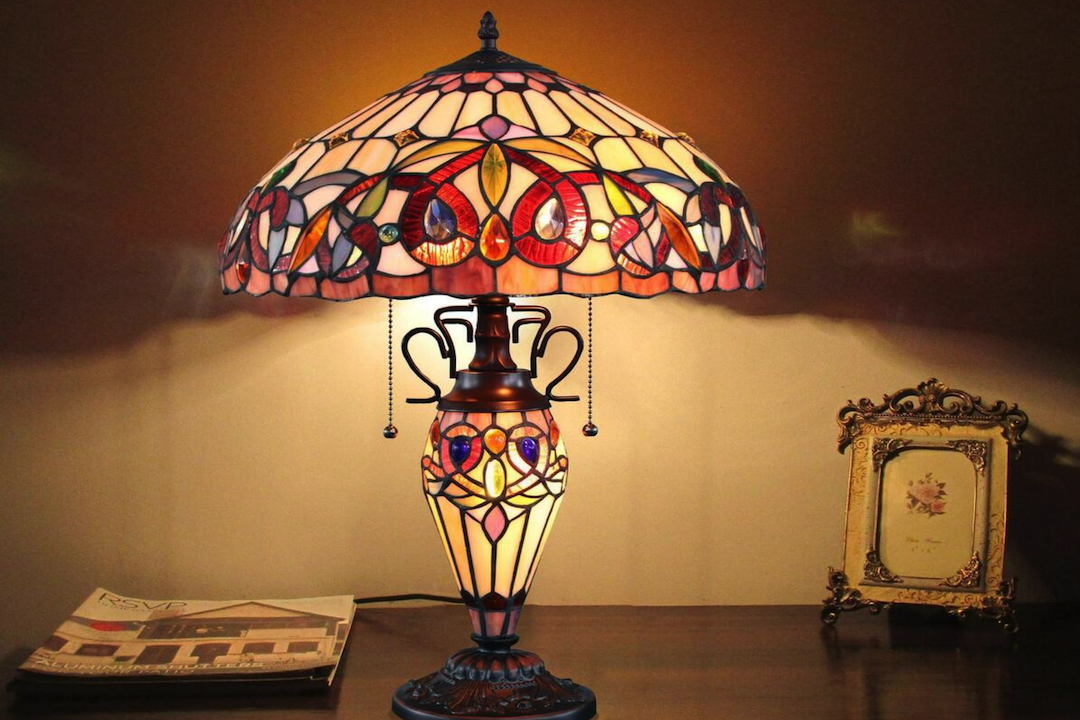The history of Tiffany glass table lamps is a fascinating journey that intertwines art, innovation, and the burgeoning American decorative arts movement of the late 19th and early 20th centuries. The story begins with Louis Comfort Tiffany, an artist and designer born in 1848, who was instrumental in the development of the Art Nouveau style in America. Tiffany founded his own company, Tiffany Studios, in 1885, which became renowned for its exquisite stained glass and decorative objects.
The introduction of the glass table lamp Miilighting in the 1890s marked a significant turning point in Tiffany’s career and the decorative arts landscape. These lamps were not merely functional; they were artistic expressions that combined beauty with utility. Tiffany’s innovative use of glass was revolutionary.
He developed a unique method of creating iridescent glass, known as Favrile glass, which allowed for a rich interplay of colors and textures. This technique involved layering different colors of glass and manipulating them through heat to achieve a variety of effects. The first Tiffany lamps were produced in 1893, and they quickly gained popularity among the affluent classes.
The lamps featured intricate designs inspired by nature, including floral motifs and dragonflies, which reflected the Art Nouveau movement’s emphasis on organic forms. As demand grew, Tiffany Studios expanded its production, employing skilled artisans who meticulously crafted each lamp, ensuring that no two pieces were exactly alike.
The Artistry and Craftsmanship of Tiffany Glass Table Lamps
The artistry and craftsmanship behind Tiffany glass table lamps are what set them apart from other lighting fixtures of their time. Each lamp is a testament to the skill and dedication of the artisans who created them. The process of making a Tiffany lamp is labor-intensive and requires a high level of expertise.
Artisans would begin by selecting the glass pieces that would be used in the lamp shade, often choosing from a vast array of colors and textures. The glass was then cut into small pieces, which were assembled into intricate patterns before being soldered together with copper foil—a technique that allowed for greater flexibility in design compared to traditional lead came methods. The attention to detail in Tiffany lamps is remarkable.
Each piece of glass is carefully chosen not only for its color but also for its ability to interact with light. When illuminated, the lamps create a warm glow that enhances the beauty of the glass, casting colorful patterns on surrounding surfaces. This interplay between light and glass is a hallmark of Tiffany’s work, showcasing his understanding of how light can transform an object into a living piece of art.
The craftsmanship extends beyond the shade; the bases of Tiffany lamps are often made from bronze or other metals, featuring ornate designs that complement the shades. This holistic approach to design ensures that every element of the lamp contributes to its overall aesthetic appeal.
The Iconic Designs of Tiffany Glass Table Lamps
Tiffany glass table lamps are celebrated for their iconic designs that have become synonymous with elegance and sophistication. Among the most famous designs is the “Dragonfly” lamp, which features a shade adorned with dragonfly motifs rendered in vibrant colors. The use of iridescent glass creates a shimmering effect that mimics the delicate wings of the insect, capturing the essence of nature in a way that is both enchanting and timeless.
Another notable design is the “Wisteria” lamp, characterized by its cascading floral patterns that evoke a sense of tranquility and beauty. The intricate layering of glass pieces in these designs showcases Tiffany’s mastery of color and form. In addition to these well-known designs, Tiffany Studios produced a wide variety of lamps that catered to different tastes and styles.
The “Peony” lamp, for instance, features bold floral patterns that are both striking and romantic, while the “Lily” lamp showcases elegant curves and soft colors that evoke a sense of serenity. Each design tells a story, drawing inspiration from nature and the world around us. The diversity in design not only reflects Tiffany’s artistic vision but also his ability to adapt to changing tastes over time, ensuring that his lamps remain relevant and desirable even today.
The Timeless Elegance of Tiffany Glass Table Lamps
The timeless elegance of Tiffany glass table lamps is one of the reasons they continue to captivate collectors and interior designers alike. These lamps possess an inherent beauty that transcends trends and fads, making them a cherished addition to any home decor. Their intricate designs and rich colors create a sense of warmth and sophistication that can enhance any space, whether it be a cozy reading nook or an opulent living room.
The ability of these lamps to blend seamlessly with various design styles—from traditional to contemporary—further underscores their enduring appeal. Moreover, Tiffany lamps are often seen as symbols of luxury and refinement. Their association with the Gilded Age—a period marked by wealth and artistic achievement—adds to their allure.
Owning a Tiffany lamp is not just about possessing a beautiful object; it is about owning a piece of history that embodies the spirit of an era defined by innovation and creativity. This timeless quality ensures that Tiffany lamps remain sought after by collectors who appreciate their artistry as well as their historical significance.
The Versatility of Tiffany Glass Table Lamps in Home Decor
Tiffany glass table lamps are remarkably versatile when it comes to home decor. Their unique designs allow them to complement a wide range of interior styles, from classic Victorian to modern minimalist settings. In traditional homes, a Tiffany lamp can serve as a stunning focal point on an antique side table or as an accent piece on a mantelpiece, enhancing the overall aesthetic with its rich colors and intricate patterns.
In contrast, contemporary spaces can benefit from the juxtaposition of a vintage Tiffany lamp against sleek furniture or minimalist decor, creating an intriguing visual contrast that draws the eye. Furthermore, these lamps can be used strategically to create ambiance within a room. Placing a Tiffany lamp in a dimly lit corner can transform an otherwise dull space into an inviting retreat, while using multiple lamps throughout an area can establish a cohesive design theme.
Their ability to cast warm, colorful light adds depth and character to any room, making them not just functional lighting solutions but also essential elements of interior design. Whether used as statement pieces or subtle accents, Tiffany glass table lamps enhance the beauty and functionality of any living space.
The Value and Collectibility of Tiffany Glass Table Lamps
Rarity and Condition: Key Factors in Value
Certain models, such as those produced during Tiffany Studios’ peak years, are particularly sought after due to their limited production runs and distinctive designs. Rare examples like the “Daffodil” or “Lotus” lamps can fetch astronomical prices at auction, sometimes reaching into six figures.
Authenticity and Provenance: Ensuring a Sound Investment
Collectors often seek out authentic pieces with documented histories to ensure their investments are sound. The presence of original shades and bases significantly impacts value; lamps that have been altered or restored may not command the same prices as those in their original condition.
Verifying Authenticity and the Growing Market for Tiffany Lamps
Reputable auction houses and galleries specializing in decorative arts often provide authentication services that help buyers verify the legitimacy of their purchases. As interest in decorative arts continues to grow, so too does the market for Tiffany lamps, making them not only beautiful additions to any collection but also potentially lucrative investments.
Caring for and Maintaining Tiffany Glass Table Lamps
Caring for and maintaining Tiffany glass table lamps is essential to preserving their beauty and value over time. Given their intricate construction and delicate materials, these lamps require special attention during cleaning and handling. Dusting should be done regularly using a soft cloth or feather duster to prevent buildup on both the glass shade and metal base.
It is crucial to avoid using harsh chemicals or abrasive materials that could scratch or damage the surface; instead, mild soap mixed with water can be used for deeper cleaning when necessary. When it comes to maintenance, checking electrical components periodically is vital for safety and functionality. Ensuring that bulbs are replaced with appropriate wattage can prevent overheating and potential damage to both the lamp and its wiring.
Additionally, if any repairs are needed—such as re-soldering loose pieces or addressing electrical issues—it’s advisable to consult professionals who specialize in antique lighting restoration. Proper care not only enhances the longevity of these exquisite lamps but also ensures they continue to be enjoyed for generations.
Where to Find and Purchase Authentic Tiffany Glass Table Lamps
Finding authentic Tiffany glass table lamps requires diligence and knowledge about reputable sources within the antiques market. Many collectors turn to established auction houses known for their expertise in decorative arts; these venues often feature curated selections of high-quality pieces accompanied by detailed provenance documentation. Renowned auction houses like Sotheby’s or Christie’s frequently hold sales dedicated to fine art and antiques where collectors can find rare Tiffany lamps.
In addition to auctions, antique shops specializing in lighting or decorative arts can be excellent places to discover authentic pieces. However, buyers should exercise caution; it’s essential to verify authenticity through documentation or expert appraisal before making a purchase. Online platforms such as 1stDibs or Ruby Lane also offer curated selections from reputable dealers but require careful scrutiny regarding authenticity claims.
Engaging with knowledgeable experts or joining collector groups can provide valuable insights into where to find genuine Tiffany lamps while ensuring informed purchasing decisions are made in this vibrant market.

